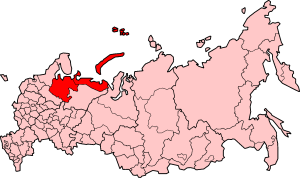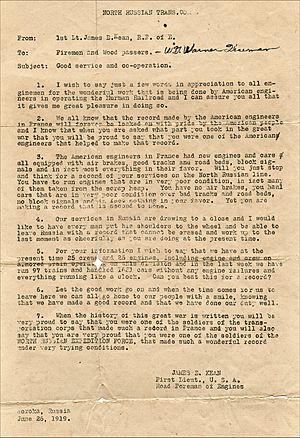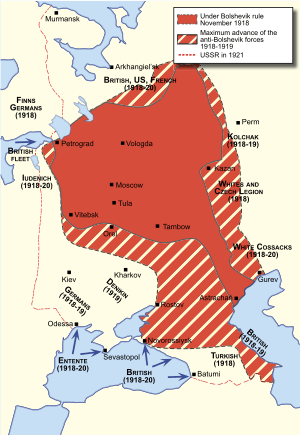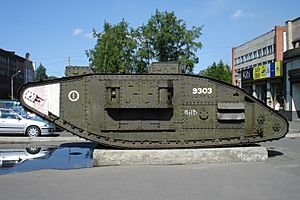North Russia intervention facts for kids
Quick facts for kids North Russia intervention |
|||||||
|---|---|---|---|---|---|---|---|
| Part of the Russian Civil War | |||||||
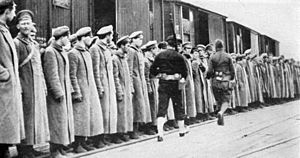 Red Army prisoners under the custody of U.S. Army troops in Arkhangelsk |
|||||||
|
|||||||
| Belligerents | |||||||
|
|||||||
| Commanders and leaders | |||||||
| Strength | |||||||
| 14,000 (estimated) | |||||||
| Casualties and losses | |||||||
The North Russia intervention was a military operation that took place during the Russian Civil War. It involved foreign troops, mainly from Allied countries like the United Kingdom, France, and the United States. These forces supported the White movement against the Bolsheviks (also known as the Red Army).
The intervention lasted from March 1918 to October 1919. It happened in the northern part of Russia, around the cities of Arkhangelsk and Murmansk. Even though the Allies tried to help the White movement, the Bolsheviks eventually won the conflict. The Allied forces then left Northern Russia.
Contents
- Why did the Allies go to Russia?
- Who were the international forces?
- Who were the opposing forces?
- Arrival in Murmansk
- Arrival in Arkhangelsk
- Fighting along the Northern Dvina River
- More fighting and challenges
- Final battles
- Allied troops leave Russia
- U.S. troops withdraw
- What happened next?
- Legacy
- The campaign in stories
- See also
Why did the Allies go to Russia?
In 1917, during World War I, Russia was going through big changes. Its leader, Tsar Nicholas II, stepped down. A new democratic government took over. The U.S. then joined World War I, fighting against Germany.
The new Russian government promised to keep fighting Germany. So, the U.S. and other Allies sent supplies to help Russia. These supplies piled up in warehouses in Arkhangelsk and the port of Murmansk.
However, in October 1917, the Bolsheviks, led by Vladimir Lenin, took power in Russia. They signed a peace treaty with Germany in March 1918. This treaty ended Russia's part in World War I. This meant Germany could move its soldiers from Russia to fight on the Western Front against Britain and France.
The Allies worried about a few things:
- They didn't want the valuable war supplies in Arkhangelsk to fall into German or Bolshevik hands.
- They wanted to help a group of soldiers called the Czechoslovak Legion. These soldiers were stuck in Russia and wanted to join the Allies.
- They hoped to restart the Eastern Front against Germany and help anti-Bolshevik forces in Russia.
Because of these worries, Britain and France asked U.S. President Woodrow Wilson for help. In July 1918, President Wilson agreed to send a small number of U.S. soldiers. Their main job was to guard military supplies and help Russians defend themselves.
Who were the international forces?
Many countries sent soldiers to North Russia. Here are some of the main groups:
British Empire
The United Kingdom sent a large number of troops and ships. This included parts of the Royal Navy, British Army, and Royal Air Force. Soldiers from Canada also joined them. They even trained some anti-Bolshevik Russian volunteers.
United States
About 5,000 soldiers from the U.S. Army were part of this mission. They were nicknamed the "Polar Bear Expedition". The U.S. Navy also sent a cruiser, the USS Olympia.
France
France sent about 2,000 soldiers, including some from their colonial forces. They also had a special group of anti-Bolshevik Russian volunteers.
Italy
Italy sent 1,350 soldiers to join the international force.
Russia
The "White Russian" forces were anti-Bolshevik Russians. They fought alongside the Allies.
Later, in May 1919, a new British force arrived. Their job was to help the Allied troops leave Russia safely. This force included some Australian volunteers who had fought in World War I.
Other countries
About 1,000 Serbian and Polish soldiers also joined the fight. There were also 30 Czechoslovak volunteers.
Who were the opposing forces?
The international forces fought against the Bolshevik Red Army. The Red Army in North Russia was made up of the Sixth and Seventh Red Armies.
Arrival in Murmansk
The first British soldiers arrived in Murmansk in March 1918. This was just after the Bolsheviks signed a peace treaty with Germany. Interestingly, the local Russian council in Murmansk had asked the Allies for help. They were worried about a German attack.
In May, British troops fought their first battle. They helped Red Guards fight against White Finns who were allied with Germany. This shows how complicated the situation was at first.
By September, British forces in Murmansk grew to 6,000 soldiers. They were joined by Italian, Canadian, and French troops. On November 11, 1918, World War I ended. This meant the main reason for the Allies being in Russia – to fight Germany – was gone. However, the British forces stayed. Their new goal was to help the White government and remove the Bolsheviks from power.
Arrival in Arkhangelsk
On August 2, 1918, anti-Bolshevik forces in Arkhangelsk took control of the city. British and French troops then sailed into the port and occupied the city. A new local government was set up, but a British general, Frederick C. Poole, was largely in charge.
Soon after, the Allies began to move south from Arkhangelsk. They used an armored train to help their advance. In September 1918, they captured a town called Obozerskaya. The British Royal Air Force even provided air support, bombing and shooting at enemy positions.
On September 4, 1918, about 4,500 American soldiers arrived in Arkhangelsk. They were led by Colonel George Stewart.
Fighting along the Northern Dvina River
A British River Force was created to use the rivers for fighting. This force included ships and gunboats. They faced many Bolshevik gunboats and mines.
Allied troops, including British, Polish, and White Russian soldiers, fought hard along the Northern Dvina River. They used amphibious attacks (land and water) and artillery. Their Lewis guns were very effective.
In September, Allied troops were pushed out of a village called Seletskoe, but they took it back three days later. The fighting was tough, and the Allies had to pull back to a defensive line for the winter. The winter was very cold, with temperatures often 40-60 degrees below freezing.
In December 1918, some White Russian troops refused to fight. Their leaders were ordered to be shot.
More fighting and challenges
Over the next few months, the Bolsheviks launched stronger attacks. They pushed the Allied forces back. In January 1919, the Bolsheviks even used poison gas shells against British positions. This was reported in the British newspapers.
On the Dvina front, a major battle happened at Tulgas in January. The Bolsheviks attacked fiercely, but the Allied forces fought back and retook the settlement.
In the Murmansk area, the British decided they needed a larger White Russian Army to win. They tried to get more recruits by capturing more populated areas. In February 1919, they launched an attack and captured a town called Segeja. They took over 3,000 square miles of land.
However, the Allies faced many challenges. The strategically important city of Shenkursk was lost to the Bolsheviks in January 1919 after a tough battle in extremely cold weather. This was a major setback for the Allies.
Many British and foreign soldiers became unwilling to fight. They had joined to fight in World War I, which was now over. There were also several cases where White Russian troops refused to obey orders or even joined the Bolsheviks. These events lowered the morale of the Allied soldiers. Some British, American, and Canadian troops also showed their unhappiness.
In April, a White Russian battalion refused to fight and some of them joined the Bolsheviks. They then attacked the Allied troops. This meant the Bolsheviks gained ground.
By May and June, many of the original British, French, and Canadian troops began to leave Russia and go home. American troops also started to withdraw. The remaining soldiers were very unhappy about staying.
In July, another White Russian unit refused to fight and killed its British officers. About 100 of them went over to the Bolsheviks. Later that month, 3,000 White troops in the city of Onega also refused to fight and handed the city over to the Bolsheviks. This was a big loss for the Allies.
Final battles
In August and September 1919, the fighting on the Dvina front became very intense. The Allies launched a big attack to try and hurt Bolshevik morale before they left. British planes dropped bombs on Bolshevik villages. They captured many Bolshevik prisoners.
On the Murmansk front, the Allies launched a final attack in September. They wanted to weaken the Bolsheviks before they withdrew. However, some of these attacks were not successful, and some British Marines refused to obey orders.
Public opinion in Britain was turning against the war in Russia. People wanted their soldiers to come home.
Allied troops leave Russia
The British government decided to pull out of Russia. General Henry Rawlinson was sent to manage the withdrawal from both Arkhangelsk and Murmansk.
The Bolsheviks did not make it easy for the British to leave. They continued to attack the British positions. However, the British forces fought back and slowly withdrew.
On September 27, 1919, the last Allied troops left Arkhangelsk. On October 12, Murmansk was also abandoned.
U.S. troops withdraw
The American soldiers also began to leave. Brigadier General Wilds P. Richardson was put in charge of making sure the U.S. forces left safely. By the end of June 1919, most U.S. troops were heading home. By September 1919, the last American soldier had left Northern Russia.
What happened next?
After the Allies left, the White Russian Army was left to fight the Red Army alone. They were not as strong or organized as the Red Army. They quickly lost ground when the Bolsheviks attacked in December 1919.
Many White soldiers surrendered. The remaining soldiers were taken out of Arkhangelsk in February 1920. On February 21, 1920, the Bolsheviks entered Arkhangelsk. On March 13, 1920, they took Murmansk. The White government in North Russia ended.
Legacy
In 1927, a monument was built in Murmansk to remember the people who died during the intervention. It is called the Monument to the Victims of the Intervention.
The campaign in stories
The North Russia intervention has appeared in books and TV shows. For example, it is mentioned in the TV show When the Boat Comes In and the film Archangel.
|
See also
 In Spanish: Campaña del Norte de Rusia para niños
In Spanish: Campaña del Norte de Rusia para niños


